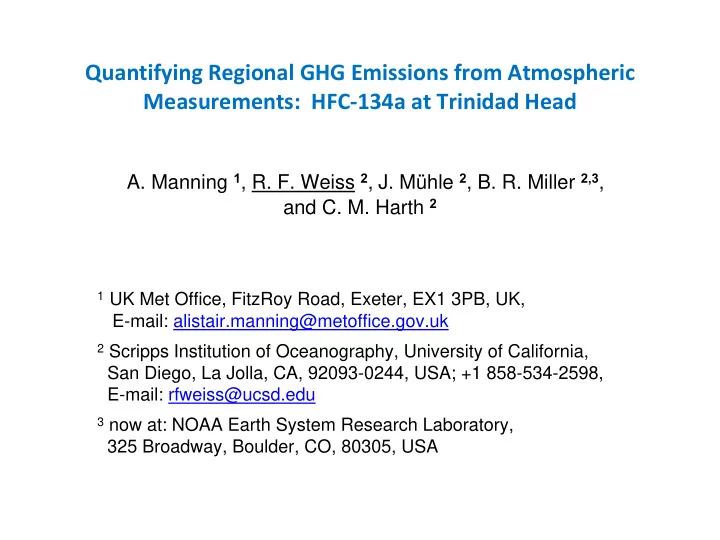

Quantifying Regional GHG Emissions from Atmospheric Measurements: HFC ‐ 134a at Trinidad Head A. Manning 1 , R. F. Weiss 2 , J. Mühle 2 , B. R. Miller 2,3 , and C. M. Harth 2 1 UK Met Office, FitzRoy Road, Exeter, EX1 3PB, UK, E-mail: alistair.manning@metoffice.gov.uk 2 Scripps Institution of Oceanography, University of California, San Diego, La Jolla, CA, 92093-0244, USA; +1 858-534-2598, E-mail: rfweiss@ucsd.edu 3 now at: NOAA Earth System Research Laboratory, 325 Broadway, Boulder, CO, 80305, USA
Legislative Action and Emissions Realities ● Nations and states around the world are legislating reductions in GHG emissions in the post-Kyoto period. ● In the US, California’s AB-32, the “Global Warming Solutions Act of 2006”, leads a 17-state effort to mandate emissions reductions. ● AB-32 requires that the state’s emissions of the Kyoto “basket” of gases be reduced (on a GWP basis) to 2000 levels by 2010, to 1990 levels by 2020, and to 20% of 1990 levels by 2050. ● Nearly all such legislation is based on “bottom up” estimates of GHG emissions inventories, which are notoriously inaccurate, especially for biogenic GHG sources. ● Can measurements of GHG accumulation in the atmosphere be used to improve estimated emissions inventories in a “top down” approach?
Trinidad Head Real-time in-situ trace gas measurement stations associated with AGAGE and collaborative organizations .
Trinidad Head AGAGE Station Northern California (41 o N, 124 o W)
AGAGE Medusa Cryotrapping GC-MS (left) and GC-Multidetector (right) Instruments at Trinidad Head, California
AGAGE MEASURED SPECIES ( Medusa in Black, GC-MD in Green, Both in Red)
UK Met Office NAME (Numerical Atmospheric-dispersion Modelling Environment) Model ● Developed following the 1986 Chernobyl incident for predicting the atmospheric transport of airborne pollutants ● Lagrangian particle model ● Predicts air concentrations, dosages and surface deposition ● Driven by 3D met data from UK Met Office Numerical Weather Prediction model (33 levels, ~40km horizontal resolution, most at lower levels, extending to 20km) ● NAME can run forwards or backwards: Where did the air come from? Where are emissions going?
Examples of NAME 10-day Air History Maps for Trinidad Head a) Clean air mass b) Polluted air mass
Number of 3-Hour Intervals Each ~40km Grid Box Contributes to the Air at Trinidad Head for Each Month of 2006 8 1 2 7 3 4 10 9 5 6 11 12
2006 Trinidad Head HFC-134a Measurements Colored by Air History Category USA
HFC-134a (ppt) Monthly NAME Baseline Estimates at the Mace Head and Trinidad Head (NH), and Cape Grim (SH) AGAGE Stations
2006 Regional HFC-134a Emissions Estimated from Trinidad Head (THD) Air Measurements and the NAME Model
Conclusions and Applications ● The regional HFC-134a emissions pattern is surprisingly reasonable, especially considering that the Trinidad Head station is sited to avoid anthropogenic emissions. ● The integrated 2006 HFC-134a emissions for the sampled area, scaled by population to the entire US, gives a total of ~43kt (range 22-60kt). An independent estimate of this value (A. McCulloch, pers. comm.) is ~75kt. ● The NAME method is easily adapted for use with multiple observation stations. Proper choice of additional station locations should yield substantial improvements in regional and integrated emissions estimates. ● This method can be applied to a broad range of anthropogenic and biogenic emissions such as those already being measured by AGAGE and other programs. ● These methods can be used for “top down” verification of GHG emissions reductions mandated by California’s AB-32 and by similar recent legislation in 16 other US states and in other countries. ● These methods could play an important role in stabilizing the volatile $30 billion global carbon-equivalent trading market.
Recommend
More recommend